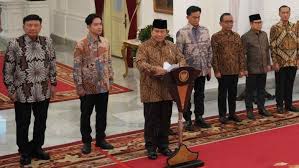Subianto Announces Indonesia’s Largest-Ever Cabinet: A New Era of Governance
Introduction to Indonesia’s Largest Cabinet
In a significant political move, Indonesian President Prabowo Subianto has announced the formation of the country’s largest cabinet to date. This unprecedented decision reflects the government’s commitment to addressing various national issues while boosting economic growth and stability. The new cabinet comprises 38 ministers, a notable increase from previous administrations, marking a shift in Indonesia’s governance dynamics.
Key Features of the Cabinet
President Subianto’s cabinet showcases a diverse range of talent and experience, with ministers from various backgrounds, including economics, social affairs, and defense. This composition aims to foster inclusive policies and effective governance. The cabinet is strategically designed to enhance coordination among ministries, ensuring that crucial policies are implemented efficiently. Notably, the appointment of young leaders aims to engage the youth and bring fresh perspectives to governance.
Goals and Objectives of the New Cabinet
The primary focus of the new cabinet is to tackle pressing challenges such as economic recovery post-COVID-19, unemployment, and infrastructure development. With Indonesia poised for substantial economic growth, the cabinet’s agenda emphasizes enhancing investment opportunities and improving the business climate. Additionally, the government is dedicated to addressing climate change and promoting sustainable development, which are vital for Indonesia’s long-term prosperity.
Public Response and Expectations
The announcement of the new cabinet has garnered mixed reactions from the public and political analysts. While many express optimism regarding the cabinet’s potential to drive positive change, some remain skeptical about the challenges ahead. The effectiveness of this cabinet will largely depend on its ability to collaborate across ministries and engage with the public.

Why This News is Important
Impact on Governance in Indonesia
The formation of Indonesia’s largest cabinet is a pivotal moment in the country’s governance, reflecting President Subianto’s vision for a more robust and responsive administration. The expansion of the cabinet signals a commitment to addressing complex societal challenges that require multi-faceted approaches. By appointing experienced ministers, the government aims to implement strategies that resonate with the diverse needs of Indonesian society.
Focus on Economic Development
In light of Indonesia’s ambitious economic goals, the cabinet’s emphasis on economic recovery and growth is crucial. The post-pandemic recovery phase presents both opportunities and challenges. A well-structured cabinet can facilitate economic policies that enhance resilience and spur growth, contributing significantly to Indonesia’s development agenda.
Engagement with Youth and Innovation
The inclusion of younger ministers indicates a strategic move to engage the youth population, which constitutes a substantial demographic in Indonesia. By fostering innovation and addressing youth-specific concerns, the cabinet can harness the potential of young leaders, driving forward-thinking policies that resonate with the next generation.
Historical Context
Indonesia has undergone significant political transformations since its independence in 1945. The country has experienced various leadership styles and cabinet configurations, each reflecting the political climate of the time. Previous administrations have formed cabinets ranging from small and streamlined to larger and more inclusive structures. The introduction of this large cabinet comes at a time when Indonesia is navigating post-pandemic recovery, economic challenges, and the need for effective governance. Historical precedents show that the effectiveness of a cabinet is often tied to its ability to respond swiftly to emerging issues and implement strategic initiatives.
Key Takeaways from “Subianto Announces Indonesia’s Largest-Ever Cabinet”
| Serial No. | Key Takeaway |
|---|---|
| 1 | Indonesia’s new cabinet comprises 38 ministers, the largest in history. |
| 2 | The cabinet focuses on economic recovery and sustainable development. |
| 3 | Young leaders are included to engage the youth and promote innovation. |
| 4 | The government aims to enhance coordination among ministries for effective governance. |
| 5 | Public response is mixed, with expectations for positive change tempered by skepticism. |
Important FAQs for Students from this News
1. What is the significance of Indonesia’s largest-ever cabinet?
The formation of Indonesia’s largest cabinet signifies a commitment to addressing national issues with a more diverse and experienced leadership. It aims to enhance coordination among ministries and tackle pressing challenges like economic recovery and sustainable development.
2. Who is the President of Indonesia, and what are his goals for the new cabinet?
Prabowo Subianto is the President of Indonesia. His goals include economic recovery post-COVID-19, tackling unemployment, promoting infrastructure development, and addressing climate change through sustainable policies.
3. How many ministers are in the new Indonesian cabinet?
The new cabinet comprises 38 ministers, marking a notable increase from previous administrations.
4. What challenges does the new cabinet aim to address?
The cabinet aims to address economic recovery, unemployment, infrastructure development, and climate change, ensuring that Indonesia’s growth is both resilient and sustainable.
5. How has the public responded to the announcement of the new cabinet?
Public response has been mixed, with optimism about potential positive changes tempered by skepticism regarding the cabinet’s ability to effectively address challenges.
Some Important Current Affairs Links















